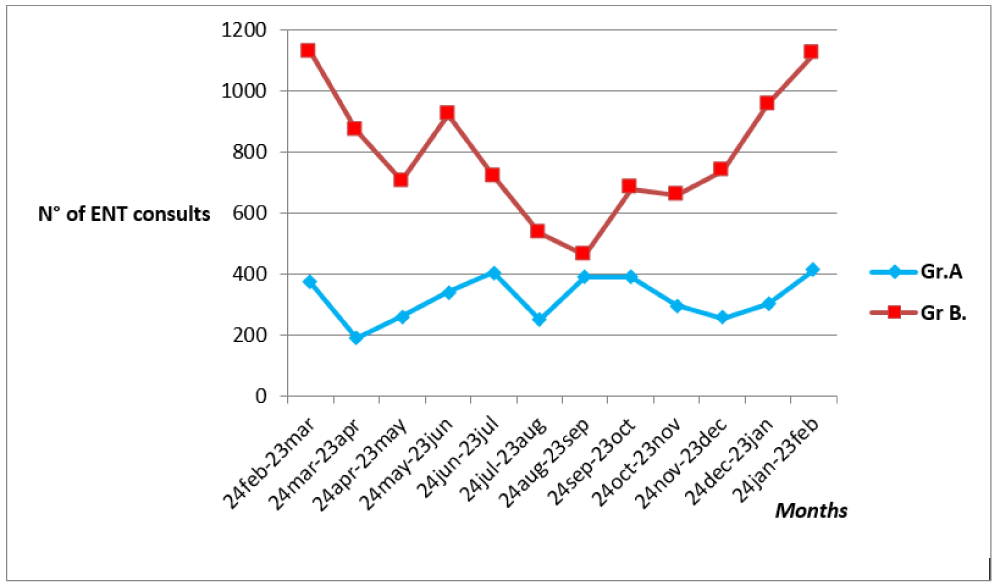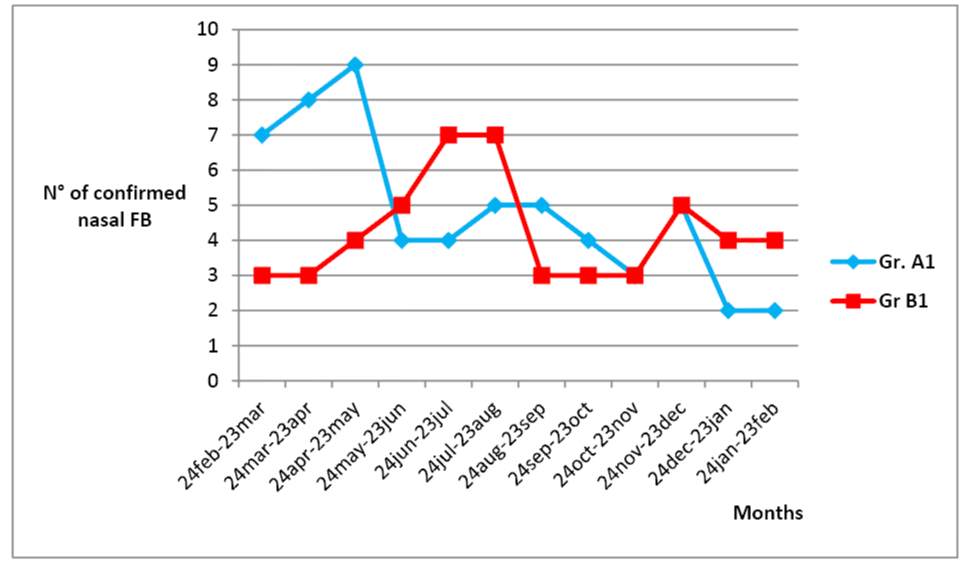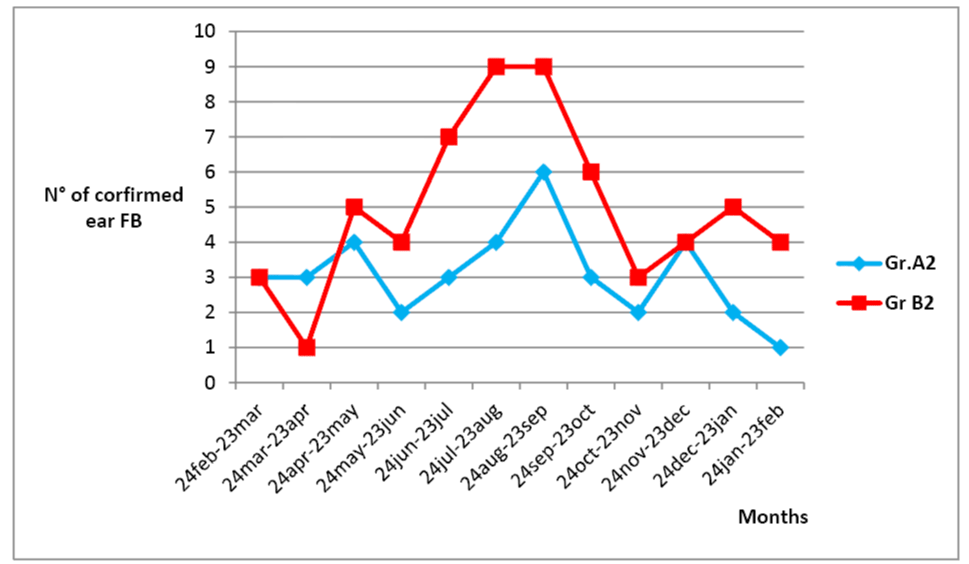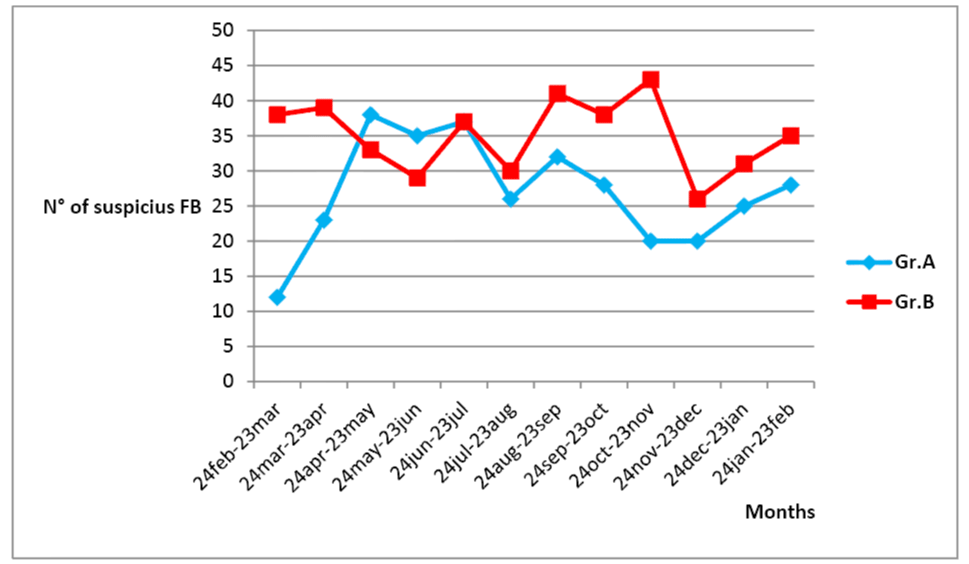Archives of Otolaryngology and Rhinology
Pediatric Ear and Nose Foreign Bodies during COVID-19 Pandemic: Is it so boring to Stay at Home?
Sabrina Garofolo*, Ivana Fiz, Andrea Melagrana, Roberto D'Agostino and Lucia Semino
Cite this as
Garofolo S, Fiz I, Melagrana A, D'Agostino R, Semino L. Pediatric Ear and Nose Foreign Bodies during COVID-19 Pandemic: Is it so boring to Stay at Home? Arch Otolaryngol Rhinol. 2024;10(2):019-023. Available from: 10.17352/2455-1759.000155Copyright
© 2024 Garofolo S, et al. This is an open-access article distributed under the terms of the Creative Commons Attribution License, which permits unrestricted use, distribution, and reproduction in any medium, provided the original author and source are credited.Introduction: During the COVID-19 lockdown children, confined at home, had a potentially increased risk of domestic accidents like the placement of foreign bodies in ears and noses. Thus, we analyzed the impact of the COVID-19 outbreak on Ear, Nose, and Throat (ENT) consultations in the ED of Giannina Gaslini Children’s Hospital in Genoa due to foreign bodies (FB).
Methods: We retrospectively analyzed all ED admissions in our Institute due to an ENT diagnosis in a year of COVID-19 emergency starting from the first day of school closure, the February 24th, 2020 (COVID-19, group A), and compared them with data from the same period of the previous year (pre COVID-19, group B). We then compared the incidence of nasal and ear FB in these two periods. We also evaluated differences in the clinical severity, type of foreign bodies, presence of complications, and need for hospitalization in these two groups.
Results: During the COVID-19 pandemic, there was a significant decrease in the need for ENT consultations (19% Group A vs. 23% Group B, p < 0.001).
However, the percentage of ENT consultations for all FB increased (8% Group A vs. 4% Group B, p < 0.001), as well as for nose FB (0.6% vs.1.8%, p < 0.001), and ear FB (0.9% vs. 0.6%, p = 0.005).
Conclusion: COVID-19 lockdown increased ENT ED accesses for foreign bodies, even though the overall need for ENT specialists in the ED decreased.
Introduction
The COVID-19 pandemic was an exceptional scenario in its outburst with a drastic impact on our lives since the end of February 2020 [1,2]. It had inevitable consequences on the health care system as well, affecting both emergency and elective activity [3].
Following the Italian lockdown announcement (March 9th, 2020) [4], pediatric institutions restricted activity to mere emergencies [5-7], postponing all elective and deferrable surgical as well as clinical activities [8-10]. These restrictions aimed to relocate human and material resources to units managing a large number of COVID-19 patients and to reduce the potential contagion of non-infected patients accessing hospitals [11].
As a consequence of a rapid increase in the incidence of COVID-19 in Italy, on the 24th of February, the Ligurian Government imposed strict containment measures and all schools and universities were closed [12].
On the 9th of March, a national lockdown was announced by the Italian Prime Minister: it has been estimated that nearly 11 million children were left home from school and playgrounds [13].
Accordingly, during the lockdown period at the IRCCS Giannina Gaslini Children’s Hospital in Genoa, Liguria, Northern Italy, it has been observed a drastic reduction of several visits to the Emergency Department (ED), probably due to the fear of the contagion [11,14], movement restrictions and social distancing.
However, long-term home isolation impacted physical and mental health and made children susceptible to increased risk of domestic accidents such as the placing of Foreign Bodies (FB) into their ears and noses [15].
The current retrospective study aimed to report variations of ENT consultations in children presented to ED of Giannina Gaslini Children’s Hospital in Genoa-Italy, for FB during the COVID-19 pandemic concerning a twelve-month pre-pandemic period. Furthermore, we evaluated if lockdown restrictions imposed by the pandemic increased or decreased the incidence of ear and nose FB, as these events mostly occur in the home setting [16].
Materials and methods
We retrospectively reviewed all ED admissions due to an ENT diagnosis in our Institute in the year of the COVID-19 emergency starting from the first day of school closure, the 24th of February 2020 (COVID-19, group A), and compared them with admissions that occurred in the year before (pre COVID-19, group B). We then compared the incidence of nasal (A1 vs. B1) and ear (A2 vs. B2) FB between groups. We evaluated differences in these two mentioned periods in the distribution of all foreign bodies, the presence of complication, and the need for FB removal in sedation as well.
All children aged less than 14 years who presented in the ED with FB were initially considered. However, ingested, and inhaled FB were excluded for further analysis, as they were mainly managed by gastroenterologists or pneumologists. The diagnosis of the ear and nose FB was confirmed during an ENT examination using photomicroscopy or transnasal fiber optic endoscopy, as appropriate. FB was then classified into main categories: toys (magnetic, wooden, plastic), food (fruit, peanut), jewelry (rings, earrings), batteries, sharp objects (pencil tip, drawing pin), coins, and rocks.
Statistical analysis
Differences in the distribution of categorical data between groups were tested by χ2 or Fisher’s exact test, as appropriate. A p - value < .05 was considered significant. Data analysis was carried out using the SPSS statistical program (SPSS, v. 24, IBM, Armonk NY, USA).
Results
We registered a decrease of 50.6% in all emergency admissions in our pediatric institution, as 19.912 patients accessed ED in the COVID-19 period, compared with 40.351 patients in the year before,Table 1. In addition to this clear general decline in the number of ED accesses, there was a significant decrease in ENT consultations as well (19% Group A vs. 23% Group B, p < 0.001), Tables 1 and 2, Figure 1. However, the number of confirmed nasal (1.5% Group A1 vs. 0.5%, Group B1, p < 0.001), and ear FB (0.9% Group A2 vs. 0.6% Group B2, p = 0.005) increased during the COVID-19 compared with the year before, Table 3, Figures 2 and 3. Even so, the percentage of confirmed FB concerning the suspicious ones, in both COVID-19 and pre-COVID-19 groups remained constant (80.5% vs. 94% for nasal and 90% vs. 87% for ear FB, respectively, p=NS), Table 2, Figure 4.
There was not any difference neither in the term of localization (right nasal cavity: 57% group A1 vs. 61% group B1, p=NS; right ear canal: 54% Group A2 vs. 62% Group B2, p=NS) nor in the type of FB (toys in the nasal cavity: 55% Group A1 vs. 35% Group B1, p=NS; toys in the ear canal: 46% Group A2 vs. 37% Group B2, p=NS; food in the nasal cavity: 28% Group A1 vs. 24% Group B1, p=NS; stone in the ear canal: 16% Group A2 vs. 37% Group B2, p=NS), Table 2.
Most of the FB extractions were performed in the outpatient setting, and patients were discharged immediately after the FB removal, Table 2. However, 6% of patients during the COVID-19 period needed hospitalization, and a FB extraction in the operation room (OR) vs. 1.8% of patients in the pre-COVID-19 group, p=NS. External otitis was the most common complication among ear FB, and it was more frequently encountered in the COVID-19 period (24.3% Group A2 vs. 5% Group B2, p < 0.05). Epistaxis and local infections were the most common complications for nasal FB (7% in Group A1 vs. 8% in Group B1, p=NS).
Discussion
To the best of our knowledge, our study is the first to evaluate the impact of the COVID-19 pandemic on the incidence of nasal and ear FB in pediatric otorhinolaryngology by analyzing twelve months of ED accesses both during the pandemic and the pre-pandemic period. We reported a significant increase in ENT pediatric consultations for both nose and ear FB during the COVID-19 pandemic, alongside a general decrease in ED accesses. The literature data concerning the incidence of ear and nose FB during COVID-19 are currently unavailable. However, most of the authors reported an overall increase in ENT FB [11,17-19]. In fact, the COVID-19 pandemic made children vulnerable as they were forced to stay at home. It is known that FB placements most frequently occur in a domestic context [19]. Furthermore, nasal and ear FB represent a common finding in pediatric populations, as children show a natural tendency to insert different objects into the nose, ears, and throat while playing [20]. Most frequently, children aged two to five years are at higher risk, according to our data. Moreover, the incidence tends to be slightly higher in males [21,22] and the most commonly found FB are food (in particular seeds and peanuts), plastic toys like beads, pencil tips, and coins inserted into the nose/ear at home or school.
Altogether, the increase in ENT consultations for ear and nose FB may reflect the change in children’s habits during the pandemic: home confinement may have resulted in an increment of accidents. Children had more free time with fewer activities available to them. Furthermore, some caregivers were engaged in smart-working, so a decrease in parental vigilance may have been partly responsible for it. However, we did not register the increase of inappropriate ED accesses for FB concerning the year pre-COVID-19, as the ratio between suspicious and confirmed FB remained constant during the COVID-19 period, most likely due to the fear of contagion.
Several authors reported a worldwide drop in overall ED admissions for both adult and pediatric patients, especially when compared with the previous year [3,8,11,18,23-28]. Similarly, there was a decrease of 50.6% of all emergency accesses in our institution, most likely due to the required self-isolation and the fear of infection. Additionally [11,23,25] the overall need for ENT pediatric consultations decreased during the COVID-19 period by more than 50% as well, presumably due to the reduction of other infectious and allergic diseases [26], possibly a consequence of movement restrictions, personal protective equipment utilization, and social distancing.
Some authors reported an increased complication rate and need for hospitalization during the COVID-19 period, presumably due to diagnostic and treatment delays caused by the pandemic. [20,24]. In our study, we reported a trend in increased hospitalization as well. On the contrary, Garg, et al. [29] described more cases of nose and ear FB removed in the theatre in the pre-pandemic period, although not statistically significant. The significant increase in external otitis as a complication of ear FB was most likely due to domestic removal attempts.
This study is not without limitations. Firstly, this is a retrospective monocentric study. Secondly, we limited our research to the ear and nose FB. However, this is due to the hospital policy, as most bronchial and esophageal FB are managed by pneumologists, and gastroenterologists, respectively.
Furthermore, in our series, the percentages (number of fb / total number of ENT admissions) were compared instead of the raw numbers. This comparison could be misleading and probably not representative of the real impact of the pandemic on the risk of pediatric home accidents. In fact, due to the fear of contagion and the decrease in other ENT infections, many patients were not admitted to the ED during 2020 and this increases the percentage of admissions to ED for FB, which is not related to a greater risk of domestic accident but to a decrease in the denominator.
Moreover, the lack of literature data regarding the incidence of ear and nose FB during COVID-19 leaves us without the possibility of comparing our results with the ones from different institutions.
Conclusion
Aside from the general impact of the COVID-19 pandemic on the health system, it changed ENT ED dynamics as well. Even though the number of ENT ED admissions decreased during the COVID-19 pandemic, in our study the incidence of ear and nose FB significantly increased, causing a higher complication rate and the need for hospitalization to remove FB in general anesthetic adding an overload to a system already in trouble. Thus, the circumstances imposed by the pandemic highlighted the importance of prevention and caregiver vigilance in reducing the incidence of nasal and ear FB that remain still a significant strain on ED.
Authors’ contributions
All authors made substantial contributions to the study. GS: designed and coordinated the study, participated in data acquisition and analysis, interpreted the data, and drafted the manuscript; FI: participated in data interpretation, statistical analysis, revision of the manuscript and gave the final approval of the version to be published; MA: participated in data interpretation; DR: participated in data interpretation; SL: designed and coordinated the study, participated in data acquisition and analysis, critically revised the manuscript for important intellectual content and gave the final approval of the version to be published.
Ethical consideration
This study was approved by the Institutional Ethics Committee of IRCSS Giannina Gaslini Genoa (approval protocol number 0011258/23).
As the study dealt with the offline retrospective analysis of anonymized data, specific approval from the institutional review boards was waived.
The research was conducted ethically, with all study procedures being performed under the requirements of the World Medical Association’s Declaration of Helsinki.
Written informed consent was obtained from each patient’s legal guardian for study participation and data publication.
- Lima CKT, Carvalho PM de M, Lima I, Nunes JVA, Saraiva JS, Souza RI, et al. The emotional impact of coronavirus 2019 – nCoV (new coronavirus disease). Psychiatry Res. 2020;287:112915. Available from: https://doi.org/10.1016/j.psychres.2020.112915
- Garzaro G, Clari M, Ciocan C, Grillo E, Mansour I, Godono A, et al. COVID-19 infection and diffusion among the healthcare workforce in a large university-hospital in northwest Italy. Med Lav. 2020;111(3):184-194. Available from: https://doi.org/10.23749/mdl.v111i3.9767
- Gallo O, Locatello LG, Orlando P, Martelli F, Bruno C, Cilona M, et al. The clinical consequences of the COVID-19 lockdown: A report from an Italian referral ENT department. Laryngoscope Investigative Otolaryngology. 2020;5:824-831. Available from: https://doi.org/10.1002/lio2.446
- Gazzetta Ufficiale della Repubblica Italiana. Decreto Legge 9 marzo 2020. Available from: https://www.gazzettaufficiale.it/eli/gu/2020/03/09/%2062/sg/pdf
- Teissier N. Reports de programmation en chirurgie ORL pédiatrique au regard de l’épidémie de COVID-19 (2020) Available from: https://www.sforl.org/wp-content/uploads/2020/04/AFOPSFORL-Report-1.pdf
- Leboulanger N, Sagardoy T, Akkari M, Ayari-Khalfallah S, Sedano C, Fayoux P, et al. COVID-19 and ENT Pediatric otolaryngology during the COVID-19 pandemic. Guidelines of the French Association of Pediatric Otorhinolaryngology (AFOP) and French Society of Otorhinolaryngology (SFORL). Eur Ann Otorhinolaryngol Head Neck Dis. 2020;137:177– 181. Available from: https://doi.org/10.1016/j.anorl.2020.04.010
- Lazzerini M, Barbi E, Apicella A, Marchetti F, Cardinale F, Trobia G. Delayed access or provision of care in Italy resulting from fear of COVID-19. Lancet Child Adolesc Health. 2020;4(5):e10-11. Available from: https://doi.org/10.1016/s2352-4642(20)30108-5
- Elli F, Turri Zanoni M, Arosio AD, Karligkiotis A, Battaglia P, et al. Changes in the use of Otorhinolaryngology Emergency Department during the COVID-19 pandemic: report from Lombardy, Italy. Eur Arch Otorhinolaryngol. 2020; 277(12):3525-3528. Available from: https://doi.org/10.1007/s00405-020-06119-z
- Castelnuovo P, Turri-Zanoni M, Karligkiotis A, Battaglia P, Pozzi F, Locatelli D; Italian Skull Base Society Board, Italian Skull Base Society Board (Società Italiana Basicranio [SIB]); Bernucci C, Iacoangeli M, Krengli M, Marchetti M, Pareschi R, Pompucci A, Rabbiosi D. Skull-base surgery during the COVID-19 pandemic: the Italian Skull Base Society recommendations. Int Forum Allergy Rhinol. 2020;10(8):963-967. Available from: https://doi.org/10.1002/alr.22596
- De Bernardi F, Turri-Zanoni M, Battaglia P, Castelnuovo P. How to reorganize an ear, nose, and throat outpatient service during the COVID-19 outbreak: report from northern Italy. Laryngoscope. 2020;130(11):2544-2545. Available from: https://doi.org/10.1002/lary.28716
- Campagnoli M, Cerasuolo M, Renna M, Dell’Era V, Aluffi Valletti P, Garzaro M. ENT Referral From Emergency Department During COVID-19: A Single-Center Experience. Ear, nose and throat J. 2023 feb;102(2):NP95-NP98. Available from: https://doi.org/10.1177/0145561320984560
- Misure urgenti in materia di contenimento e gestione dell'emergenza epidemiologica da COVID-19. Regione Liguria. (20A01272) (GU Serie Generale n.47 del 25-02-2020)
- UNESCO. COVID-19 Impact on Education. UNESCO Institute for Statistics (UIS); 2020. Available at: Available from: https://en.unesco.org/covid19/educationresponse.
- Khan S, Siddique R, Li H, Ali A, Shereen MA, Bashir N, et al. Impact of coronavirus outbreak on psychological health. J Glob Health. 2020;10(1):010331. Available from: https://doi.org/10.7189/jogh.10.010331
- Rabia A, Singh SP. Lockdown Boredom in COVID-19 Pandemic: As a Cause of Pediatric Foreign Bodies. Indian J Otolaryngol Head Neck Surg. 2022;74(Suppl 2):2799-2800. Available from: https://doi.org/10.1007/s12070-020-02262-5
- Orsagh-Yentis D, McAdams RJ, Roberts KJ, McKenzie LB. Foreign-Body Ingestions of Young Children Treated in US Emergency Departments: 1995-2015. Pediatrics. 2019;143(5):e20181988. Available from: https://doi.org/10.1542/peds.2018-1988
- Pizzol A, Rigazio C, Calvo PL, Scottoni F, Pane A, Gennari F, et al. Foreign-body Ingestions in Children During COVID-19 Pandemic in a Pediatric Referral Center. JPGN Rep. 2020;11:1(2):e018. Available from: https://doi.org/10.1097/pg9.0000000000000018
- Atru B, Sutrave M, George R, James R, Ross A, C B P. Otolaryngology Surgical Activity in Tertiary Care Center During the Covid-19 Lockdown. Indian J Otolaryngol Head Neck Surg. 2022;74(Suppl 2):2758-2763. Available from: https://doi.org/10.1007/s12070-020-02155-7
- Pecorari G, Tavormina P, Riva G, Landolfo V, Raimondo L, Garzaro M. Ear, nose and throat foreign bodies: the experience of the Pediatric Hospital of Turin. J Paediatr Child Health. 2014;50(12):978-984. Available from: https://doi.org/10.1111/jpc.12673
- Roy S, Jain N, Narang E, Singh J, Gupta N. Impact of COVID Lockdown on the Presentation of Nasal Foreign Bodies to a Tertiary Care Center. Ear, Nose & Throat J. 2022;101(10):NP453-NP458. Available from: https://doi.org/10.1177/0145561320981438
- Baranowski K, Al Aaraj M, Sinha V. Nasal Foreign Body. 2023 In: StatPearls. Available from: https://www.ncbi.nlm.nih.gov/books/NBK459279/
- Kiger JR, Brenkert TE, Losek JD. Nasal foreign body removal in children. Pediatr Emerg Care. 2008;24(11):785-92; quiz 790-2. Available from: https://doi.org/10.1097/pec.0b013e31818c2cb9
- Stansfield J, Dobbs S, Harrison R, Lee K, Sharma S, Okour K, et al. Management of ENT emergencies during the coronavirus disease 2019 pandemic. J Laryngol Otol. 2021;135(2):117-124. Available from: https://doi.org/10.1017/s0022215121000530
- Bucci C, Caruso F, Quitadamo P, Tipo V, Martemucci L, Marmo R. COVID-19 lockdown led to fewer ingestion cases but a higher percentage of more serious cases needed hospitalization. Acta Paediatrica. 2021;110:1293–1294. Available from: https://doi.org/10.1111/apa.15748
- Carré F, Leboulanger N, Thierry B, Simon F, Couloigner V, Denoyelle F, et al. Impact of COVID-19 lockdown on a tertiary center pediatric otolaryngology emergency department. Eur J Pediatr. 2022 feb;181(2):647-652. Available from: https://doi.org/10.1007/s00431-021-04236-3
- Son Y, Park J, Choi Y, Kim H, Kang J, Smith L, et al. National trends of allergic diseases and pandemic-related factors among individuals with obesity in South Korea: A nationwide representative serial study, 2005-2021. Heliyon 10 (2024) e29921. Available from: https://doi.org/10.1016/j.heliyon.2024.e29921
- Patel VM, Kominsky E, Tham T, Bottalico D, Setzen M, Ferastraoaru D, et al. The impact of the COVID-19 pandemic on otolaryngologic emergency department visits at two major NYC hospital systems. Am J Otolaryngol. 2021;42(5):103123. Available from: https://doi.org/10.1016/j.amjoto.2021.103123
- Hervochon R, Atallah S, Levivien S, Teissier N, Baujat B, Tankere F. Impact of the COVID-19 epidemic on ENT surgical volume. Eur Ann of otorhilolaryng, head and neck diseases. 2020;137:269-271. Available from: https://doi.org/10.1016/j.anorl.2020.08.006
- Garg J, De Castro F, Puttasidiah P. Ear, nose, and throat foreign bodies in the pediatric population: did the COVID-19 lockdown change anything? Cureus. 2022;14(8):e27892. Available from: https://doi.org/10.7759/cureus.27892
Article Alerts
Subscribe to our articles alerts and stay tuned.
 This work is licensed under a Creative Commons Attribution 4.0 International License.
This work is licensed under a Creative Commons Attribution 4.0 International License.






 Save to Mendeley
Save to Mendeley
